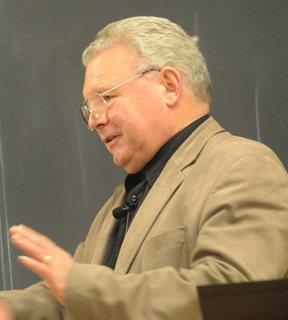
That quote sound familiar? Chemical ecologist Jacques Le Magnen (1916-2002) said that back in 1970.
World-renowned organic chemist Wittko Francke (right) of the University of Hamburg, Germany, called attention to Le Magnen's quote at a UC Davis Department of Entomology seminar on Wednesday noon, Dec. 8.
It bears repeating: "Nature is more a world of scents than a source of noise."
Insects communicate in a chemical language or chemical signals, Francke told the crowd.
Indeed, scientists have long known that methods that can attract or repel insects have important applications for agricultural pests and medical entomology.
Francke told how a queen bee secretes compounds that regulate development and behavior of the colony, and how an orchid releases the scent of a female wasp to attract male wasps— a scent that results in pollination. He also touched on the “calling cards” of a number of other insects, including bumble bees, wasps, pea gall midges, stingless bees, bark beetles and leafminers. He pointed out that that plants, too, send chemical signals.
UC Davis graduate students James Harwood and Amy Morice of the James R. Carey lab video-taped the seminar. It will be online soon at http://entomology.ucdavis.edu/news/webcastlinks.html
Francke was introduced by chemical ecologist-forest entomologist (and UC Davis Department of Entomology affiliate) Steve Seybold of the USDA Forest Service, Pacific Southwest Research Station, Davis.
No stranger to UC Davis, Francke previously collaborated with chemical ecologist Walter Leal, professor and former chair of the UC Davis Department of Entomology, on attractants for navel orangeworm.
In his talk, Francke mentioned Leal’s discovery of a sophisticated mechanism for the isolation of the chemical communication channels of two species of scarab beetles.
Seybold and Francke are collaborating on the chemical signals of the walnut twig beetle, which in association with a newly described fungus, causes thousand cankers disease, a killer of walnut trees.
Thousand cankers disease (TCD) is now found in seven western states, plus Tennessee. Seybold is a key researcher in California.
Scientists believe that TCD occurs only on walnut, predominantly native black walnut, Juglans californica and J. hindsii, although the disease has been recorded on 10 species of walnuts or their hybrids in California.
Often the first symptoms of TCD are flagging and yellowing leaves and branch dieback, said Seybold, who has been studying the chemical ecology and behavior of bark beetles for more than 25 years. Affected branches show sap staining and pinhole-sized beetle holes. Beneath the surface are dark stains caused by the fungus.
A USDA/UC Davis research team is tracking the pathogen and the beetle throughout California, particularly in commercial orchards.
That all points back to “Nature is more a world of scents than a source of noise.”
Attached Images:

They Deal with Scents